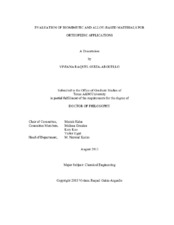| dc.description.abstract | The basic principle of tissue engineering is the combination of appropriate cells with biomaterials under conditions that promote and lead to tissue formation. A tissue engineering scaffold is a material that supports cells for their growth, proliferation, and differentiation in the absence of native extracellular matrix (ECM). The ECM was originally thought to provide primarily a mechanical support for the cells, but through receptors on the surface of cells, the ECM takes part in promoting cell adhesion, migration, growth, differentiation, and apoptosis. Ideally, a tissue engineered scaffold should mimic both the form and function of native ECM. Additionally, like any other biomaterial for implantation, a tissue engineered scaffold should be biocompatible and not initiate tissue reactions or immune responses.
This work focuses on the evaluation of the biocompatibility of novel alloy-based materials for orthopedic applications. In addition, in the context of bone regeneration, it examines the influence of select native ECM constituents on mesenchymal stem cell (MSC) osteogenic differentiation in 3-D contexts. On the other hand, given the crucial role of vasculogenesis in cell nutrition in the scaffolds, ECM mimics found to support osteogenesis were further evaluated for endothelial cell adhesion and migration. For the hydrogel systems presented in this manuscript, poly(ethylene glycol) diacrylate (PEGDA) networks were selected as the base scaffold due to the broad tunability of their mechanical properties and their previous use in bone regeneration applications. In addition, pure PEGDA hydrogels do not intrinsically promote cell adhesion. Thus, cell interactions with PEGDA gels are initially isolated to the interactions supported by the proteins tethered to the scaffold.
This work attempts to contribute to the development of novel materials that provide biocompatibility and enhanced versatility in orthopedic applications. Moreover, in the context of bone regeneration, the use of selective ECM biomolecules in hybrid hydrogel scaffolds will aid in the understanding of MSC osteogenic responses to specific ECM constituents. Additionally, incorporation of ECM mimics that support both osteogenesis and vasculogenesis will provide a more controlled platform which will serve as a foundation for the fabrication of more efficient vascularized bone constructs. | en |


